“We are currently struggling with children who can’t speak English and follow around two of our Educators that speak Mandarin. Our other Educators have tried to build connections, but the children don’t go near them. Our Mandarin Educators are struggling to be available for other children as they need to spend most of their time helping these children settle and explain everything to them.”
0 Comments
|
| Mr Potato Head providing bright opportunities to engage and involve all children in book- reading. Mr Potato Head recently inspired me to think and consider how we can engage and include the whole body in book reading to include all children by:
|
My commitment to supporting the participation and communication skills of all children inspired me to develop the information sheet from many years of problem solving and responding to the needs of different learners and communicators.
It was wonderful to partner with Diversity Kids to support in translating this Information Sheet sheet in several languages including Arabic, Nepalese, Cantonese, Mandarin and Vietnamese.
This information is supported by Diversity Kids as I am pleased to work with them in their commitment to to enable true inclusion of all children within early childhood settings.
Check out the Diversity Kids website for copies of these translated information sheets, and feel free to download to share with your Educators & families.
“I have a magic ball”- Nisrine’s vision to engage the whole body in book reading
I have always believed that when children enjoy interactions with books, they will be motivated to learn language. The vision behind I Have a Magic Ball was that it could be read with groups of children and with children who may not engage with books just by sitting and listening. I wanted to create a story that comes to life, allows children to imagine and interact by throwing, catching and passing a ball while they read this story. Check out my website at www.nisrineelchoueifati.com to purchase the book or find out more.
CLICK ABOVE TO DOWNLOAD TRANSLATED INFORMATION FLYERS
Many refugee families come to Australia from different parts of the world, for diverse reasons and with a vast range of experiences. As Teachers and Early Childhood Educators, there are many ways we can ensure that our services and classrooms are well informed about their journey, and readily equipped to offer supportive, welcoming and inclusive environments.
What is the difference between a migrant and a refugee?
Migrants make a conscious decision to relocate and, in many instances, have been selected because they have valuable skills to bring to their new country.
Refugees however, flee their country for their own safety and usually cannot return unless the situation that forced them to flee improves. Furthermore, refugees have typically been exposed to high levels of trauma and significant periods of severe deprivation prior to their selection for resettlement. Transition to their new life in their new country therefore presents many challenges. Asylum Seekers are those that flee their own country and apply to the government of another country for protection, as refugees.
Over the last few years in Australia, the countries of origin of refugees and humanitarian entrants have been Syria, Iraq, Afghanistan, Iran, Myanmar, Bhutan, the Democratic Republic of Congo and recently Ukraine. Over 800,000 refugees and displaced persons have settled in Australia since 1945 (Department of Immigration and Border Protection, 2013-2014).
As Teachers and Early Childhood Educators, we can be prepared to receive refugee children & their families, by skilling ourselves up and tailoring our programs and environments to accommodate the unique challenges and sensitivities experienced by the refugee children and families that come through the doors of our education and care settings. Working with and supporting the inclusion of refugee children & families enables practical application of our own cultural competence skills.
Treat each child & family as unique with a life story of their own.
It is important to think of the journey of every refugee child and their family as unique. There is no ‘one size fits all’ refugee experience and therefore no single mode of support that we can offer.
As Educators, we need to be mindful of some of the issues that affect refugee children & families and develop strategies & support mechanisms that are meaningful, authentic and sensitive to their individual needs. For example, some children may be experiencing emotional issues including anxiety, fear or grief. It is highly likely that opportunities for play would have been minimal and that developmental milestones have been delayed. It is also likely that they have experienced trauma and have possibly been exposed to violence and death. One of our Ukrainian Bilingual Educators that is currently supporting the inclusion of a refugee child at her child care centre, reports that the child regularly engages in dramatic play around nursing & providing medical care for her wounded doll.
Equally as important is the need for us to be mindful of the problems associated with stereotyping and labelling refugee children and families. We should never assume anything about a refugee child, their family or their situation. From the onset, there is always great value in self and critical reflection around our own personal definition and perception of “refugees and the refugee experience”. There is so much value in unlearning some of our previous learning and dismantling and replacing some of our assumptions with knowledge acquired through real life cultural competence building experiences.
We should also endeavour to understand the unique experiences of the children and families that become part of our education and care community. We can best do this through intensive research and planning, demonstrating kindness and empathy and by putting ourselves in their shoes when delivering culturally sensitive programs & support. We can better inform ourselves about their experiences, by having conversations with various agencies that support these families, keeping up to date with current, relevant literature and asking those sensitive but insightful questions of families. Such steps help us develop authentic, meaningful relationships and connections. They also help create an environment where families feel safe to leave their child.
What are some useful practical tips & strategies that help facilitate inclusion and welcome of refugee children and families?:
Services that can offer support to refugee children & families:
1. Refugee Council of Australia
www.refugeecouncil.org.au
Ph: (02) 9211 9333
2. Services for the Treatment And Rehabilitation of Torture and Trauma Survivors (STARTTS)
www.startts.org Ph: (02) 9794 1900
3. NSW Refugee Health
www.swahs.nsw.gov.au Ph: (02) 8778 0770
4. Settlement Services International
www.ssi.org.au Ph: (02) 8799 6700
5. Migrant Resource Centres
6. Asylum Seekers Centre
https://asylumseekerscentre.org.au Ph: (02) 9078 1900
Useful resources/books for children:
My Two Blankets – Irena Kobald
My Name is Not Refugee – Kate Milner
Refugees – David Miller
What is a Refugee? – Elise Gravel
Hello – A Counting Book of Kindnesses – Hollis Kurman
References
Department of Immigration and Border Protection, 2013-2014
Early Childhood Australia, Every Child, Cultural Considerations – Welcoming Refugee Children & Families Into Our Services, Vol. 22, No. 2, 2016: 8-9
What is the difference between a migrant and a refugee?
Migrants make a conscious decision to relocate and, in many instances, have been selected because they have valuable skills to bring to their new country.
Refugees however, flee their country for their own safety and usually cannot return unless the situation that forced them to flee improves. Furthermore, refugees have typically been exposed to high levels of trauma and significant periods of severe deprivation prior to their selection for resettlement. Transition to their new life in their new country therefore presents many challenges. Asylum Seekers are those that flee their own country and apply to the government of another country for protection, as refugees.
Over the last few years in Australia, the countries of origin of refugees and humanitarian entrants have been Syria, Iraq, Afghanistan, Iran, Myanmar, Bhutan, the Democratic Republic of Congo and recently Ukraine. Over 800,000 refugees and displaced persons have settled in Australia since 1945 (Department of Immigration and Border Protection, 2013-2014).
As Teachers and Early Childhood Educators, we can be prepared to receive refugee children & their families, by skilling ourselves up and tailoring our programs and environments to accommodate the unique challenges and sensitivities experienced by the refugee children and families that come through the doors of our education and care settings. Working with and supporting the inclusion of refugee children & families enables practical application of our own cultural competence skills.
Treat each child & family as unique with a life story of their own.
It is important to think of the journey of every refugee child and their family as unique. There is no ‘one size fits all’ refugee experience and therefore no single mode of support that we can offer.
As Educators, we need to be mindful of some of the issues that affect refugee children & families and develop strategies & support mechanisms that are meaningful, authentic and sensitive to their individual needs. For example, some children may be experiencing emotional issues including anxiety, fear or grief. It is highly likely that opportunities for play would have been minimal and that developmental milestones have been delayed. It is also likely that they have experienced trauma and have possibly been exposed to violence and death. One of our Ukrainian Bilingual Educators that is currently supporting the inclusion of a refugee child at her child care centre, reports that the child regularly engages in dramatic play around nursing & providing medical care for her wounded doll.
Equally as important is the need for us to be mindful of the problems associated with stereotyping and labelling refugee children and families. We should never assume anything about a refugee child, their family or their situation. From the onset, there is always great value in self and critical reflection around our own personal definition and perception of “refugees and the refugee experience”. There is so much value in unlearning some of our previous learning and dismantling and replacing some of our assumptions with knowledge acquired through real life cultural competence building experiences.
We should also endeavour to understand the unique experiences of the children and families that become part of our education and care community. We can best do this through intensive research and planning, demonstrating kindness and empathy and by putting ourselves in their shoes when delivering culturally sensitive programs & support. We can better inform ourselves about their experiences, by having conversations with various agencies that support these families, keeping up to date with current, relevant literature and asking those sensitive but insightful questions of families. Such steps help us develop authentic, meaningful relationships and connections. They also help create an environment where families feel safe to leave their child.
What are some useful practical tips & strategies that help facilitate inclusion and welcome of refugee children and families?:
- Gain insight and understanding of their refugee experience. Imagine yourself stepping into the shoes of the child and reflect on their recent journey, prior to arriving at your Service. Listen & watch carefully – putting the pieces together and getting the full picture does not happen overnight. When working with them, take on an education and care experience through their eyes. Try and see things through their lens and come up with strategies that you think will help create a place that makes them feel settled, less afraid, more comfortable and safe. Sometimes it is important to look outside the box, particularly in humanitarian examples such as these and find ways to help remove any barriers or additional trauma. We are currently working with Child Care Centres to support Ukrainian children and families that have fled the war in Ukraine – many of our practices have been modified and adapted to remove red tape, provide immediate language & cultural support and offer flexible, relaxed options and solutions, that focus on the child and family, building sense of trust and security and forming partnerships.
- ‘Belonging, Being & Becoming’ – The Early Years Learning Framework – takes on a different perspective in the context of refugee children & families. For us at Diversity Kids, the primary focus here includes creating an environment & programs that nurture and instil a warm, comfortable, happy & safe sense of belonging that support the children to work through their feelings & anxieties - by providing and maintaining a safe, nurturing, familiar and predictable care environment and one where the refugee child feels comfortable and safe in their experiences and identity. Focussing on their sense of Belonging and nurturing their well Being will help contribute to their Becoming the best version of themselves.
- Don’t be afraid to ask the difficult questions of the families about their child’s needs, interests, abilities, strengths, likes, dislikes and what matters to them about the care and education you will be providing to their child. Encourage the family to stay as long as they like in the education & care environment and to participate and role model elements of language & cultural support they would like to see provided for their child. Support them to share important aspects of their culture and activities that are familiar to their child.
- Access programs such as the Inclusion Support Program and Bilingual/Cultural Support. Our Bilingual Educators are a practical language & culture resource, that can play a critical role in supporting refugee children and their families in their education & care environments by acting as a communication bridge, helping build trust, connections, a sense of cultural safety & belonging. They can work alongside Educators to help determine interests, strengths, areas of concern and support the child to be understood and understand what is going on around them and what is expected of them in their education & care settings. Bilingual Educators can help the child understand by communicating ‘in language’, but can also help guide the child and help them learn key words in English. Some of these Bilingual Educators may be of refugee status themselves and can help Educators gain better insight of on so many levels, providing strategies to assist with cultural transition and ways to connect with refugee communities.
- Develop inclusive programs and programs that are respectful of diversity for all the children at your service. , Introduce, with the aim of gradually embedding - programs and activities that structure discussions about refugees, migration, kindness, inclusion, empathy, diversity, mutual respect and social justice. Ensure that all the children in your education and care environments have voices and are heard – including your refugee children. There are many resources for children including books that can be used to introduce the refugee experience to children. See resource list below.
- Provide culturally & language appropriate services for your refugee families (Bilingual/Cultural Educators, bilingual staff, interpreters, translated information) and deliver culturally and linguistically relevant activities that promote the child’s home language, cultural identity and cultural self esteem. This can help provide a sense of familiarity, cultural safety and inclusion. Display and use key child care words in the relevant dialects, help teach the refugee children key words in English to enable smooth transition and support them to build on social skills with peers & Teachers.
- Offer innovative ways to assist children’s feelings and anxieties through for example, mindfulness & well being programs, offer calm, relaxing experiences and activities such as music, water play, yoga, breathing exercises and a sensory resources/room/space.
- Provide direct support to families to access other specialist support services & help provide cross agency solutions for your refugee children and families. (refer to list below). Develop connections with staff from local migrant & refugee settlement support services, participate in local child, family and community services interagency meetings or events.
- Find ways to acknowledge, celebrate, include and encourage your new refugee families to participate at your Service and feel that they belong. Refugee children and their families are assets to every education & care community. Their experiences come with strengths, abilities and cultural knowledge that we can all learn and grow from on our cultural competence journey.
Services that can offer support to refugee children & families:
1. Refugee Council of Australia
www.refugeecouncil.org.au
Ph: (02) 9211 9333
2. Services for the Treatment And Rehabilitation of Torture and Trauma Survivors (STARTTS)
www.startts.org Ph: (02) 9794 1900
3. NSW Refugee Health
www.swahs.nsw.gov.au Ph: (02) 8778 0770
4. Settlement Services International
www.ssi.org.au Ph: (02) 8799 6700
5. Migrant Resource Centres
6. Asylum Seekers Centre
https://asylumseekerscentre.org.au Ph: (02) 9078 1900
Useful resources/books for children:
My Two Blankets – Irena Kobald
My Name is Not Refugee – Kate Milner
Refugees – David Miller
What is a Refugee? – Elise Gravel
Hello – A Counting Book of Kindnesses – Hollis Kurman
References
Department of Immigration and Border Protection, 2013-2014
Early Childhood Australia, Every Child, Cultural Considerations – Welcoming Refugee Children & Families Into Our Services, Vol. 22, No. 2, 2016: 8-9
One of the best ways to understand & support the inclusion of every child, is by stepping into their shoes and getting a perspective of how they feel and what they may be experiencing.
This helps us plan and work towards ensuring that we get inclusion right for every individual child and that no child experiences exclusion.
Through our work at Diversity Kids, we often hear from children themselves, grateful for their Bilingual Educator who helps them understand and be better understood. Or the children we observe through our intervention and inclusion support that are feeling happier and comforted knowing that their Educators are becoming better equipped to support their unique inclusion needs and that their peers are becoming more inclusive, accepting and understanding.
It all begins with the welcome. When the child walks through the door every morning, what are they telling you about how safe, included and welcome they feel? Do you see signs of confidence, connection & belonging? Does the child feel safe and happy enough to farewell family without issue and participate meaningfully during a positive and fulfilling day? One can usually pick up signals from the onset around barriers that need to be addressed in order for the child to experience a happier & more inclusive time in their education & care setting.
For every child to participate fully, it is important that their voices are heard & that they are understood by their fellow peers & Educators. For some children, this means, additional support to give them louder voices and also help them better understand what is expected of them throughout the day. We always need to be looking for ways to ensure that every voice is heard and that every child is given an opportunity to authentically and meaningfully engage and participate without any barriers. Keep an eye out throughout the program as to who is not contributing or constantly appear to be distracted or disruptive and ask yourself whether your intervention to address & remove any current barriers may help.
It is important that as Educators, we regularly reflect and check in to see that no child is struggling to participate in our programs. If they do, they do not have the capacity to ask for help – it is our responsibility as Educators to find solutions to help them overcome any obstacles (whether this means language support, accommodations & modifications to our programs or building our confidence, knowledge & capacity around inclusion and inclusive practices).
Every child feels better included and a greater sense of connection & belonging when they see themselves and can relate to the resources & programs we provide every day. Diversity Kids advocates for “mirror & window” programs & resources, to heighten a sense of inclusion and diversity for all children. When children look at books, toys, dolls embedded in your programs they should be able to see reflections of themselves – like looking at a mirror. These resources should also give children an opportunity to open doors and explore the diversity around them.
Inclusion for the child operates holistically with various factors and interactions coming into play – from our inclusive actions as Educators to finding ways to ensure that all families are given the opportunity to participate, contribute and belong. Nothing makes a child feel more included than a child who participates fully and can see that their family experiences the same.
A child might not be able to tell you whether they feel included or not or what they need to be included. As adults, we can reflect, put ourselves in their shoes and try to experience belonging through their eyes. We know that every child is being included, when every child thrives, participates meaningfully & fully and that their education & care setting feels safe and just like home.
This helps us plan and work towards ensuring that we get inclusion right for every individual child and that no child experiences exclusion.
Through our work at Diversity Kids, we often hear from children themselves, grateful for their Bilingual Educator who helps them understand and be better understood. Or the children we observe through our intervention and inclusion support that are feeling happier and comforted knowing that their Educators are becoming better equipped to support their unique inclusion needs and that their peers are becoming more inclusive, accepting and understanding.
It all begins with the welcome. When the child walks through the door every morning, what are they telling you about how safe, included and welcome they feel? Do you see signs of confidence, connection & belonging? Does the child feel safe and happy enough to farewell family without issue and participate meaningfully during a positive and fulfilling day? One can usually pick up signals from the onset around barriers that need to be addressed in order for the child to experience a happier & more inclusive time in their education & care setting.
For every child to participate fully, it is important that their voices are heard & that they are understood by their fellow peers & Educators. For some children, this means, additional support to give them louder voices and also help them better understand what is expected of them throughout the day. We always need to be looking for ways to ensure that every voice is heard and that every child is given an opportunity to authentically and meaningfully engage and participate without any barriers. Keep an eye out throughout the program as to who is not contributing or constantly appear to be distracted or disruptive and ask yourself whether your intervention to address & remove any current barriers may help.
It is important that as Educators, we regularly reflect and check in to see that no child is struggling to participate in our programs. If they do, they do not have the capacity to ask for help – it is our responsibility as Educators to find solutions to help them overcome any obstacles (whether this means language support, accommodations & modifications to our programs or building our confidence, knowledge & capacity around inclusion and inclusive practices).
Every child feels better included and a greater sense of connection & belonging when they see themselves and can relate to the resources & programs we provide every day. Diversity Kids advocates for “mirror & window” programs & resources, to heighten a sense of inclusion and diversity for all children. When children look at books, toys, dolls embedded in your programs they should be able to see reflections of themselves – like looking at a mirror. These resources should also give children an opportunity to open doors and explore the diversity around them.
Inclusion for the child operates holistically with various factors and interactions coming into play – from our inclusive actions as Educators to finding ways to ensure that all families are given the opportunity to participate, contribute and belong. Nothing makes a child feel more included than a child who participates fully and can see that their family experiences the same.
A child might not be able to tell you whether they feel included or not or what they need to be included. As adults, we can reflect, put ourselves in their shoes and try to experience belonging through their eyes. We know that every child is being included, when every child thrives, participates meaningfully & fully and that their education & care setting feels safe and just like home.
Is it great to celebrate? Exploring the celebration debate!
The cultural, linguistic & religious diversity of Australia inevitably presents itself in our education and care settings. Consequently, we need to be developing & delivering culturally inclusive and authentic programs that reflect the diversity of our classrooms and are meaningful to our children & families.
Celebrations are a very important aspect of culture (being either religious, festive, historical or nationally based), however, quite often Educators view celebrations as challenging on various levels.
The common challenges we hear about include:
- “Celebrations are too hard & a very sensitive area, so we would rather not celebrate.” “We don’t want to be disrespectful or do the wrong thing, so we prefer to have a “No Celebrations Policy.”
- Celebrations are not relevant, age appropriate or meaningful to all children & families.
- Families may oppose the involvement of their children in various celebrations – including those that may contradict their religious or moral views.
- Celebration programs focus on the commercial or ‘exotic’ which highlights difference and doesn’t provide authentic information to children on how people live their daily lives.
- Celebrations may verge on promoting stereotype – the idea that all members of a particular group or culture share the same attitudes and values about a particular celebration.
- Uncertainty around which celebrations to recognise, in order to be inclusive and equitable.
Diversity Kids believes that “it’s great to celebrate!”. Challenges and concerns can be unpacked and worked through. With reflection, consultation, collaboration, some guiding tips & strategies, the celebration journey can be a meaningful, authentic, inclusive, educational and fun learning experience for everyone involved.
Why celebrate?
- Celebrations help foster a positive sense of self and self identity in children, and contribute to increased pride in cultural identity, self esteem, cultural being and sense of belonging.
- When we recognise days that are special to families and cultural groups, it demonstrates that we value them. Consider it as an opportunity for children and families to share a special holiday or tradition.
- Celebrations provide children, Educators and families with an opportunity to learn about values, experiences and celebrations that are different from their own (or even similar to theirs).
- Celebrations can create an extension of the child’s home environment and help celebrate the child’s cultural being – celebrations demonstrate caring for and educating the child in a cultural context.
- Celebrations provide opportunities for Services to develop inclusive policies & practices that celebrate diversity.
- Celebrations provide opportunities for developing & building respectful partnerships with families through establishing cultural connections. If you have families that celebrate, ask for their input & ideas. Invite your families to help lead the celebrations and participate.
- Celebrations are a good opportunity for Educators to reflect on their cultural competence journey, share aspects of their culture and reflect on how cultural and religious diversity and celebrations are reflected in their program.
Tips & ideas to consider when planning celebrations:
- Reflect on your current Celebrations practices as a team & Service.
- Develop a Celebration policy to help your Service choose, implement & evaluate celebration programs & activities. Evaluate you Celebration policy every year to check in on whether all staff & families still find it relevant and appropriate.
- Ensure that your Celebration policy incorporates the cultural and linguistic needs of all your children, families and staff and that policies are translated so that all families are able to provide input. Ensure that your policy respects the right of families and children to not participate in celebrations.
- Reflect on how you choose celebrations that are meaningful, developmentally appropriate and inclusive to the children, families & community.
- Focus on events that are culturally relevant to individual children, families & Educators. Keep Celebrations inclusive, relevant, developmentally appropriate and have fun celebrating! Consider what celebrations contribute to forming each child’s identity within the Australian community.
- Incorporate a question in your enrolment form that asks families what celebrations are important to them, what they would like to celebrate and how.
- Consult with the children about their current interests around celebrations, what they would like to celebrate & how. This helps develop their sense of agency and belonging. Offer children authentic learning experiences based on their prior knowledge & experiences.
- Consider the values we want to impart with in children through what we chose to celebrate. The key is to ensure that there is balance in our celebrations and in the messages we leave with children about the celebration. eg. an appreciation of diversity, inclusion, respect & belonging.
- Explore the diverse (and similar) ways in which families & Educators celebrate events/festivals.
- With religious celebrations, it is important that all families are informed and consulted. The key is to reflect this in your Celebration policy and ensure that all religious celebrations and cultural festivals are reflected in your overall programming and celebrations so that ALL children and families feel included.
- Present celebrations equally, rather than focus on one festival in depth. Do you have children & families that celebrate at particular times of the year? (eg Ramadan, Diwali etc). Start with these celebrations, and over time, you can move towards celebrating more diverse festivals, especially if the values that you want to foster in children include an appreciation of cultural diversity.
- Keep in mind that it’s impossible to celebrate everything. In Education and Care, we are bombarded with a plethora of celebrations, “days” “weeks” for us to genuinely cover and address. Sometimes acknowledgement of this celebration is adequate.
- Children’s interests are a good starting point, and be sure to tap into your in-house Educator resources and any associated local community events (eg Moon Festival event through local council or cultural organisation).
- Ensure that celebrations are not just celebrated as a program ‘add-on’, but rather the values and messages we want to instill in the children are embedded all year round. Incorporate celebrations into your every day curriculum (through books, puzzles, games, music & movement, storytelling) not just stand alone, tokenistic events.
- Celebrations usually start on the surface level of culture (eg art/craft, music, food etc). In every day family life, cultural festivals have deeper meaning (such as celebrating religion, family relationships). The challenge for programming respectfully & authentically around celebrations is to also incorporate cultural information and understanding at a deeper level alongside the fun activities. Be sure to discuss the meaning of the celebration/holiday/festival with children.
- Begin by incorporating celebrations that are relevant to individual children and families in your program. Invite the families to become involved and share their celebrations. Through their guidance and input, we are in a better position to provide non stereotypical and respectful celebrations (that move beyond the celebrations through art & craft activities, but also enable the conversations around the meaning & significance behind the celebration).
- Parent consultation, input & participation is important. Develop a system to encourage family/Centre communication (eg. notice board, digital, Newsletter, informal conversations, surveys) giving parents the opportunity to let you know when a celebration is coming up.
- Set up a library of items for loan to families and ask families if you can borrow celebratory items from them. eg books, greeting cards, traditional dress, artefacts, decorations.
- Research and tap into opportunities to celebrate with your local community. eg Local Festival excursion or cultural celebratory incursion.
- Extend on your cultural competence and learn about celebrations that can be explained to children and build on their existing knowledge.
What happens when families do not want their children to participate in particular celebrations?
Quite often, families do not want their children to participate in particular celebrations, for various reasons (eg contradiction of moral or religious views). Policies should respects the right of families and children to not participate in celebrations and families who do not wish to be involved in celebrations should have options for ‘opting out’. Offer appropriate alternatives for children and families who chose not to participate in celebrations.
References:
M. Casley, Celebrating With Children: A Cultural Perspective, Diversity in Child Care Queensland, STTAR Program, 2001.
M. Tsambouniaris, Festivals and Celebrations, Bankstown Early Integration and Networking Group, 2004
Extract from Putting Children First, the magazine of the National Childcare Accreditation Council (NCAC) Issue 33, March 2010 (pages 17-19), Genuine Celebrations: Including cultural experiences in the program.
Cultural Connections, Child Australia, 2017
What is Cultural Competence?
The Early Years Learning Framework describes Cultural Competence as “much more than an awareness of cultural differences. It is the ability to understand, communicate with and effectively interact with people across cultures”.
The team at Diversity Kids believe that Cultural Competence is also about recognising that all children are born belonging to a culture. These children often come to our education and care settings with strong cultural identities that may involve traditional practices, values that they are raised with, celebrations and knowledge.
Cultural Competence embodies Educators taking the time and making an effort to understand the unique sense of culture & belonging that each child experiences within their cultural community and as Educators, working towards creating a care environment that offers a similar sense of belonging (like an extension of the child’s home environment).
Cultural Competence has both a visible, tangible layer (including things like purchasing multicultural & Aboriginal resources and embedding these in every day practices, celebrating cultural festivals, inviting Aboriginal people to come and tell stories, translating information for families and so on).
There is also another layer to Cultural Competence that has more to do with our attitudes, knowledge, the relationships we make, the connections we build with our children & families, the way we extend on our knowledge base and our attitudes towards diversity. It includes the way we effectively communicate and interact with children, families & people across cultures.
One of the keys to cultivating Cultural Competence is our ability to view Cultural Competence as an ongoing, integral part of a continuous learning process, a life long journey, rather than a destination.
Cultural Competence and the experience of it varies from person to person and from situation to situation. It requires a growth mindset, a quest for knowledge around cultures & diversity, ongoing reflection that leads to identifying, learning from and implementing new opportunities and putting cross cultural practices into action. In essence, Cultural Competence is an opportunity for limitless learning, an exchange of information, connection and collaboration.
Developing and cultivating your Cultural Competence invites you to begin by looking into your own cultural background – the experiences, values and knowledge of your own culture, family and community history - and recognising that people from other cultures may not share them.
Cultural Competence is also looking at everything through a cultural lens and building that into your everyday practices, policies, programs and philosophies.
What are some tips, tools & skills to help Educators become culturally competent?
Diversity Kids has developed a Checklist that describes some of the characteristic attitudes, skills & knowedge required to be a Culturally Competent Educator. Below is an excerpt from that Checklist:
Culturally Competent Educators:
Self Reflection:
Attitudes:
Knowledge:
Practices:
What does Cultural Competence mean? How do we do it? How do we become it?
Cultural Competence means different things to different people. Everyone’s Cultural Competence journey is unique. We are all at different stages of our journey but the most important thing is that we start this journey and take the small steps, even if at times we feel that our approach wavers on the tokenistic.
Over time, with ongoing reflection, opportunities, practice, perseverance and a commitment to continue the journey, one is able to cultivate their competence around culture. This eventually leads to an enriched journey of cultural confidence with tools & knowledge to better communicate, include and interact cross culturally with children, families and Educators that we work with and in our everyday personal interactions.
References:
https://wehearyou.acecqa.gov.au/2014/07/10/what-does-it-mean-to-be-culturally-competent/
The Early Years Learning Framework describes Cultural Competence as “much more than an awareness of cultural differences. It is the ability to understand, communicate with and effectively interact with people across cultures”.
The team at Diversity Kids believe that Cultural Competence is also about recognising that all children are born belonging to a culture. These children often come to our education and care settings with strong cultural identities that may involve traditional practices, values that they are raised with, celebrations and knowledge.
Cultural Competence embodies Educators taking the time and making an effort to understand the unique sense of culture & belonging that each child experiences within their cultural community and as Educators, working towards creating a care environment that offers a similar sense of belonging (like an extension of the child’s home environment).
Cultural Competence has both a visible, tangible layer (including things like purchasing multicultural & Aboriginal resources and embedding these in every day practices, celebrating cultural festivals, inviting Aboriginal people to come and tell stories, translating information for families and so on).
There is also another layer to Cultural Competence that has more to do with our attitudes, knowledge, the relationships we make, the connections we build with our children & families, the way we extend on our knowledge base and our attitudes towards diversity. It includes the way we effectively communicate and interact with children, families & people across cultures.
One of the keys to cultivating Cultural Competence is our ability to view Cultural Competence as an ongoing, integral part of a continuous learning process, a life long journey, rather than a destination.
Cultural Competence and the experience of it varies from person to person and from situation to situation. It requires a growth mindset, a quest for knowledge around cultures & diversity, ongoing reflection that leads to identifying, learning from and implementing new opportunities and putting cross cultural practices into action. In essence, Cultural Competence is an opportunity for limitless learning, an exchange of information, connection and collaboration.
Developing and cultivating your Cultural Competence invites you to begin by looking into your own cultural background – the experiences, values and knowledge of your own culture, family and community history - and recognising that people from other cultures may not share them.
Cultural Competence is also looking at everything through a cultural lens and building that into your everyday practices, policies, programs and philosophies.
What are some tips, tools & skills to help Educators become culturally competent?
Diversity Kids has developed a Checklist that describes some of the characteristic attitudes, skills & knowedge required to be a Culturally Competent Educator. Below is an excerpt from that Checklist:
Culturally Competent Educators:
Self Reflection:
- Are aware of their own world view.
- Reflect on how their own cultural background influences their belief systems, biases and how they view the world (as a key part of critical reflection).
- Have an awareness of their own cultural values and views and how this may impact on their ability to work across cultural boundaries.
- Engage in ongoing reflection relating to their Cultural Competence and how they build children’s Cultural Competence in the process.
Attitudes:
- Respect & embrace diversity and develop positive attitudes towards cultural differences.
- Understand, honour and have a positive attitude to different cultures, languages, traditions, child rearing practices.
- Have an authentic respect for diversity, equity, fairness, inclusion, social justice and the richness it brings to our society.
Knowledge:
- Gain and extend on knowledge of different cultural practices and perspectives (through professional development, cultural resources, conversations with families and ethnic communities).
Practices:
- Ensure that everyone is on a cultural competence journey including children, Educators & families.
- Help children to become culturally confident, respectful of diversity, Ambassadors of inclusion, social justice and intolerant to racism and injustice.
- Develop strong cross cultural communication skills to communicate and interact across cultures.
- Build strong cross cultural relationships with fellow Educators, children & families.
- Encourage bilingualism & maintenance of children’s culture / home language, including Aboriginal & Torres Strait Islander culture and languages.
- Challenge discriminatory viewpoints.
- Are able to participate in intercultural settings on both a personal and professional level. Use resources that are culturally meaningful & relevant.
- Adapt curriculums to children’s ideas, interests and culture.
What does Cultural Competence mean? How do we do it? How do we become it?
Cultural Competence means different things to different people. Everyone’s Cultural Competence journey is unique. We are all at different stages of our journey but the most important thing is that we start this journey and take the small steps, even if at times we feel that our approach wavers on the tokenistic.
Over time, with ongoing reflection, opportunities, practice, perseverance and a commitment to continue the journey, one is able to cultivate their competence around culture. This eventually leads to an enriched journey of cultural confidence with tools & knowledge to better communicate, include and interact cross culturally with children, families and Educators that we work with and in our everyday personal interactions.
References:
https://wehearyou.acecqa.gov.au/2014/07/10/what-does-it-mean-to-be-culturally-competent/
We recently received a query from a Diversity Kids follower that inspired us to write up a blog & develop a resource with tips & strategies.
When we talk about teaching children about cultural diversity and embedding it in our Services and programs to help create future ambassadors of Inclusion & Diversity, it is just as important to do this in education & care settings where there is no diversity represented and where classrooms are primarily monocultural.
Children all over the world are growing up in heterogenous and multicultural societies.
Regardless of whether they are experiencing diversity in their current circumstances or not, chances are they will in time be exposed to diversity in their wider community and future experiences. For this reason, it is important that children learn about similarities and differences and learn to respect and accept people, practices, beliefs, attitudes, cultures, abilities and experiences that are different to their own.
By teaching young children about diversity in early childhood, we are exposing them to different ways of life from an early age and encouraging them to see differences as positive, exciting and enriching opportunities and quite often as “just a different way of doing things.” This also helps build a strong sense of self, identity and self-esteem which will be carried through in later life.
As Early Childhood Teachers we are in a very influential position to embed cultural awareness, cultural competence, sensitivity to & respect for diversity, from a very early age through the programs and resources we chose to deliver and share in our education and care environments.
The ideal place to start is through enriching children’s experiences with meaningful multicultural perspectives as an integral part of all programs for young children. Even if there are only one or two cultures represented at your Service, these two are a great place to start. You may even find that once you start scratching the surface and finding opportunities to ask the right questions (for example through your enrolment forms), you may discover that families are from Culturally & Linguistically Diverse Backgrounds that you were not aware of.
Another great place to start sharing culture, is through the cultural competence journey of Educators at your Services. There is value in introducing & sharing our cultures as Educators to the children & families that we’re working with. It’s all relative to embedding culture meaningfully & authentically and an excellent way to introduce culture and diversity to children within their own community.
I always like to share the example of a team in a primarily monocultural rural setting, with children & families attending, primarily from English speaking backgrounds. The staff at this Service reflected on building on their cultural competence with an innovative initial project, that had some interesting, unforeseen spin off effects with staff, children & families around cultural competence. The team were invited to include & share something important from their own family or cultural life in their staff profiles (which were displayed in the foyer and in children’s resources). Staff were also encouraged to include any languages other than English that they spoke and flag(s) representing their cultural backgrounds.
Almost immediately staff recognised similarities and explored differences with each other.
It created opportunities for conversation – to listen, to learn and understand. In response, the families of the children voluntarily started sharing what was important to their families and cultures.
Through this activity, Educators were able to unpack missed cultural information about children & families that had not been previously made available. This is turn helped Educators start building on embedding cultural perspectives in their everyday programs that were meaningful.
If your Service is monolingual, another important step we recommend is to research the cultural demographics of the local community (including local Aboriginal communities and cultures) and start implementing & embedding multicultural activities as inbuilt to the whole Service functioning on an every day basis, reflecting the diverse cultures, backgrounds, languages & religions which are represented in the local community and beyond. Such programs respect & promote all cultures, so that children from as young as 5 years have good, positive feelings about themselves and others.
We recommend that cultural programs are sprinkled everywhere, every day, all the time, across all areas of the program and curriculum, rather than setting up cultural corners or having cultural months.
There are many examples of ways diverse cultures can be embedded in the every day practices of monocultural classrooms:
- Greet children & families in key home languages identified as relevant to the child care & local community (and beyond if relevant).
- Learn key words in different languages & Sign Language and use them every day in interactions (eg. “Please”, “thank you”, “hello”, “goodbye”). This example helps demonstrate to children that there are many different ways to communicate the same thing.
- Invite families & Educators from Culturally & Lingusitically Diverse Backgrounds to share their culture (eg. Storytelling, dance, cooking, song, art/craft). Continue to implement and extend on these activities.
- A simple way to introduce and embed culture into your every day is by embedding food from different cultures in your program. For example, include a different type of bread from around the world with children’s meals ever day. eg damper, pita bread, roti, nan, Lebanese bread, French stick, bagel, Vienna bread, focaccia, baguette, chapatti, tortilla or make available different eating utensils and give children the choice.
- Learn to sing a well known songs in their diversity of languages. Eg “Twinkle Twinkle Little Star” is sung by children in different languages across the globe, “Good Morning” song in different languages etc.
- There are many traditional children’s games that are played by children all over the world. Research the variations and incorporate these in your program. eg. There are so many cultural variations to traditional children’s games such as“The Handkerchief” “London Bridge” and “Ring a Ring o’ Roses”.
- Ensure that your resources reflect diversity that is not represented at your Service. Eg Dolls with different skin tones, from diverse backgrounds, with disabilities, books that reflect diversity of children and people from a range of cultural, religious backgrounds and with diverse abilities. We at Diversity Kids like to think of resources as “mirrors & windows” – where children not only get to see themselves in the resources but also become immersed in the diversity of the outside world they have yet to experience.
- Have conversations with children about diversity and what it means to them. Introduce activities that enable them to explore the diversity of their skin colour, hair & eye colour. Emphasising the similarities even in our differences.
- You can take children on non tokenistic “cultural” journeys by using the globe to talk about the different parts of the world that we live in, experiencing virtual cultural journeys, tapping into children’s books that focus on different cultures around the world and things that can be extended into fun learning experiences for children to build knowledge (including learning language, cooking, songs, games).
- Give children a choice to participate in developmentally appropriate “culture workshops” – where they get to learn about a particular culture through hands on art/craft, storytelling, language, music movement etc. Cultural Workshops can be embedded in programs regularly where children get to choose their “workshop”.
- Resources depicting diversity and which help create cultural awareness, do not have to be expensive. Diversity Kids has an expansive list of some great resources that we use with Services that we support around cultural inclusion (refer to our online store for some ideas). Multicultural resources can be inexpensive by developing your own! For example, source bilingual magazines, travel brochures, posters and create matching games, laminated puzzles, posters, art/craft activities, collages etc.
Even in our monocultural classrooms, we can find ways to introduce meaningful programs that embrace and embed cultures, diversity and community. By starting early we help pave the way for future societies that are inclusive and respectful of diversity.
Author
Meni Tsambouniaris
Multicultural Consultant
Archives
March 2024
February 2024
May 2023
September 2022
August 2022
June 2022
March 2022
October 2021
August 2021
July 2021
April 2020
January 2020
July 2019

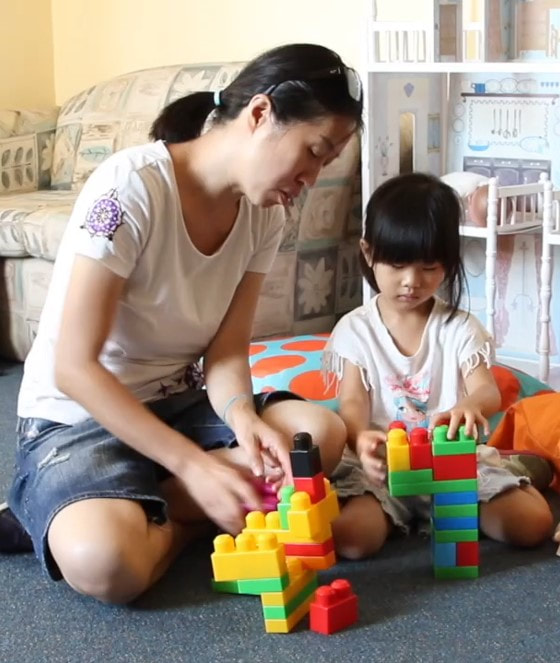
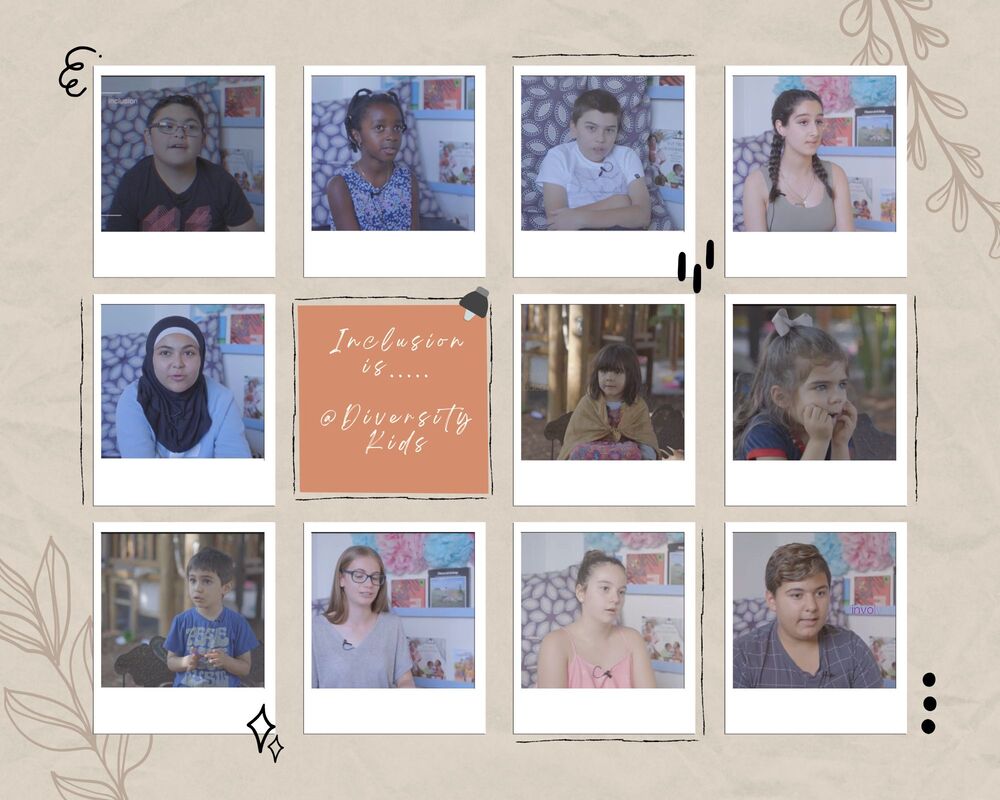
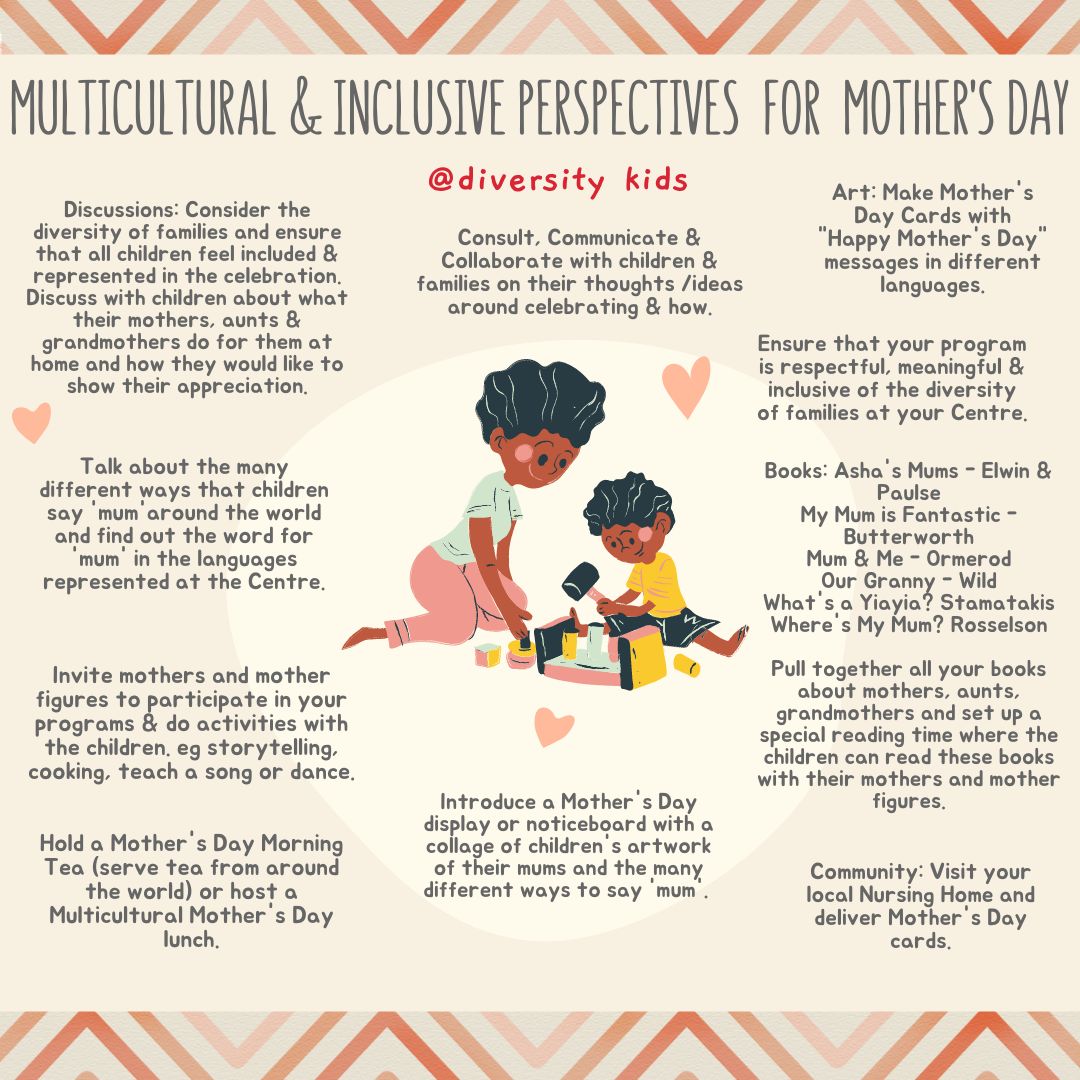
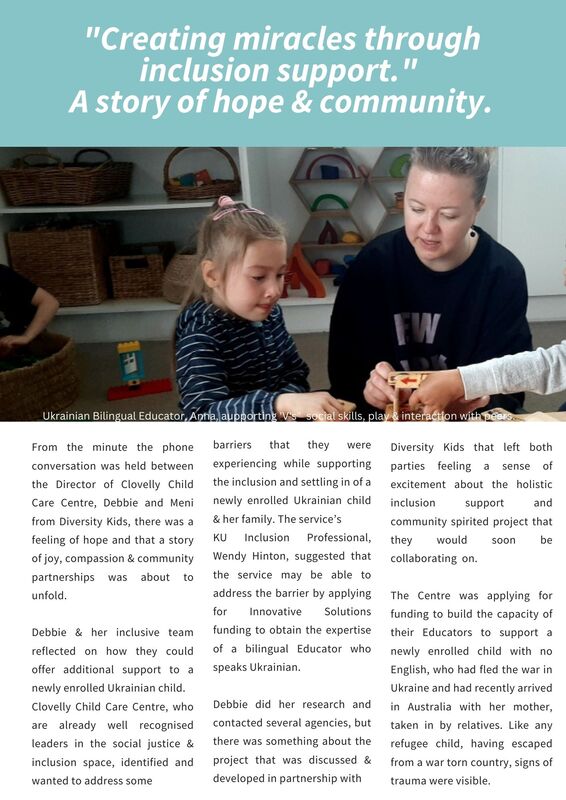
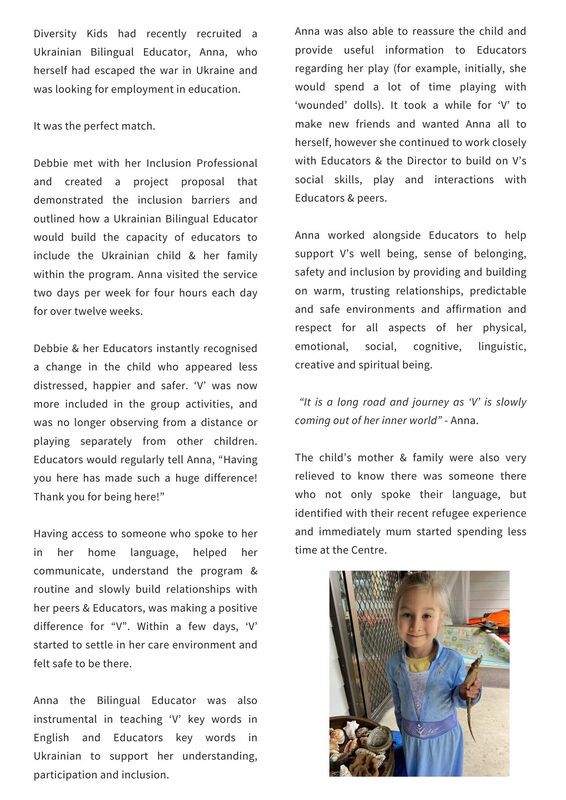
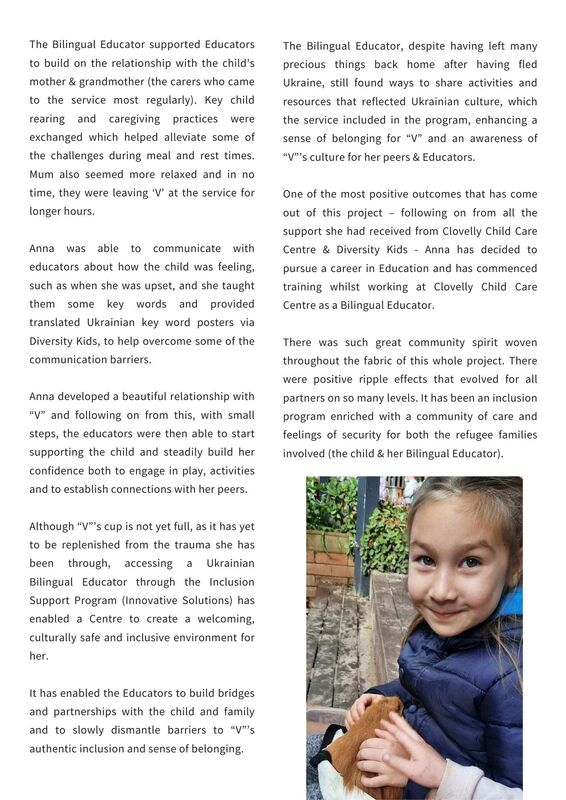
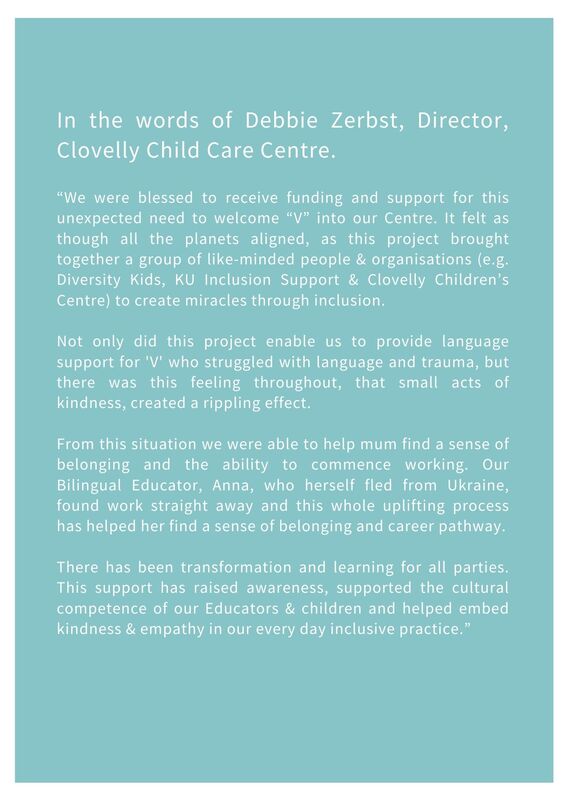
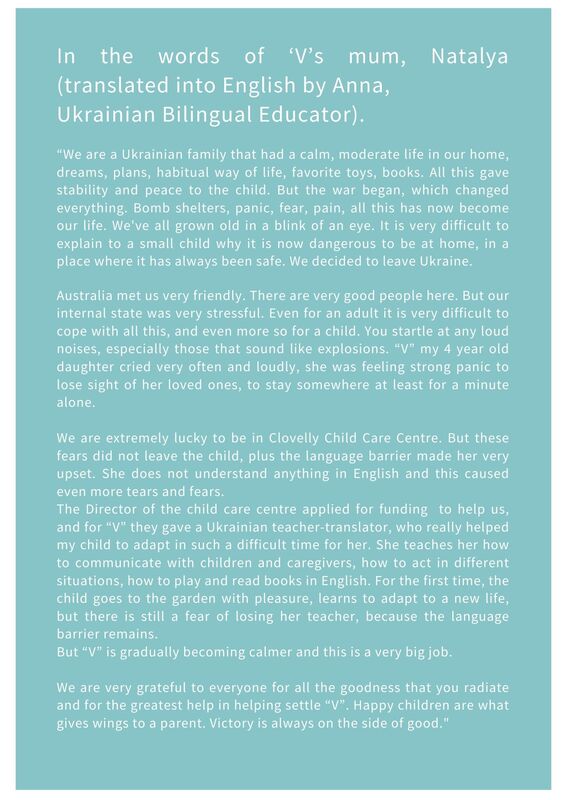
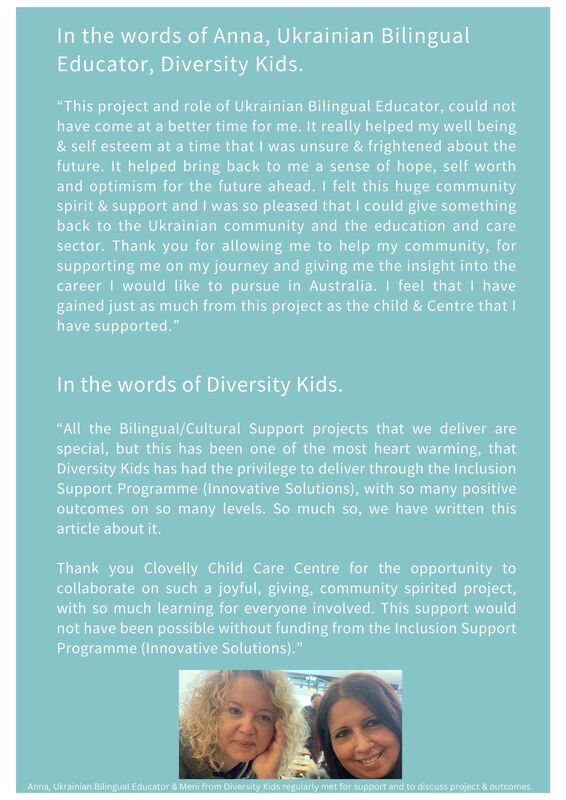
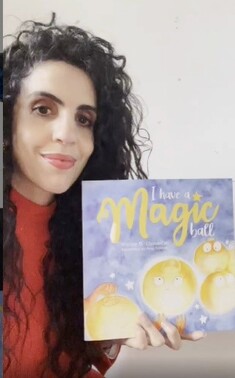
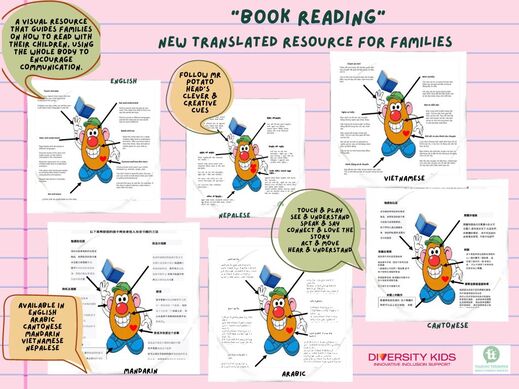
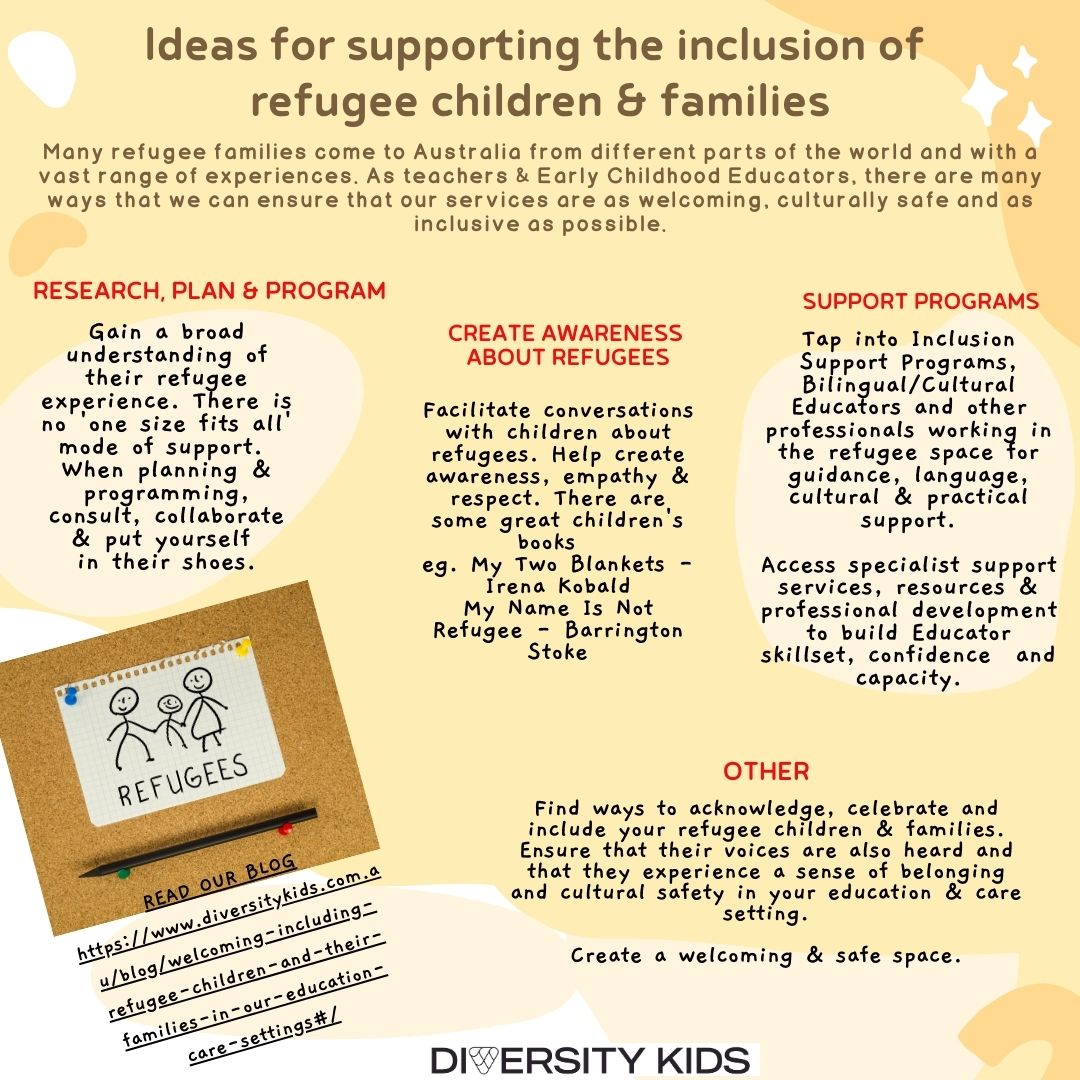
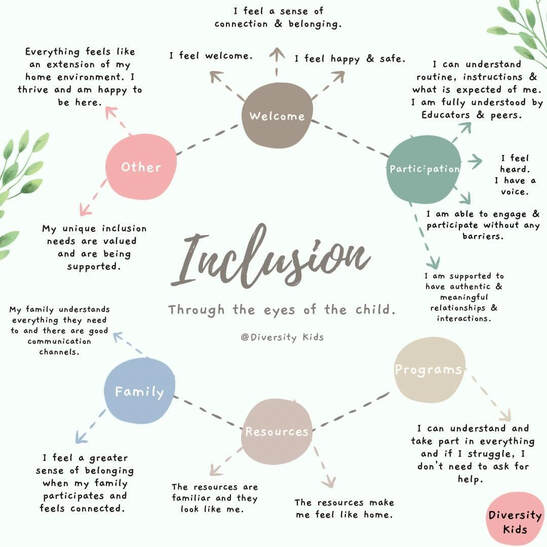
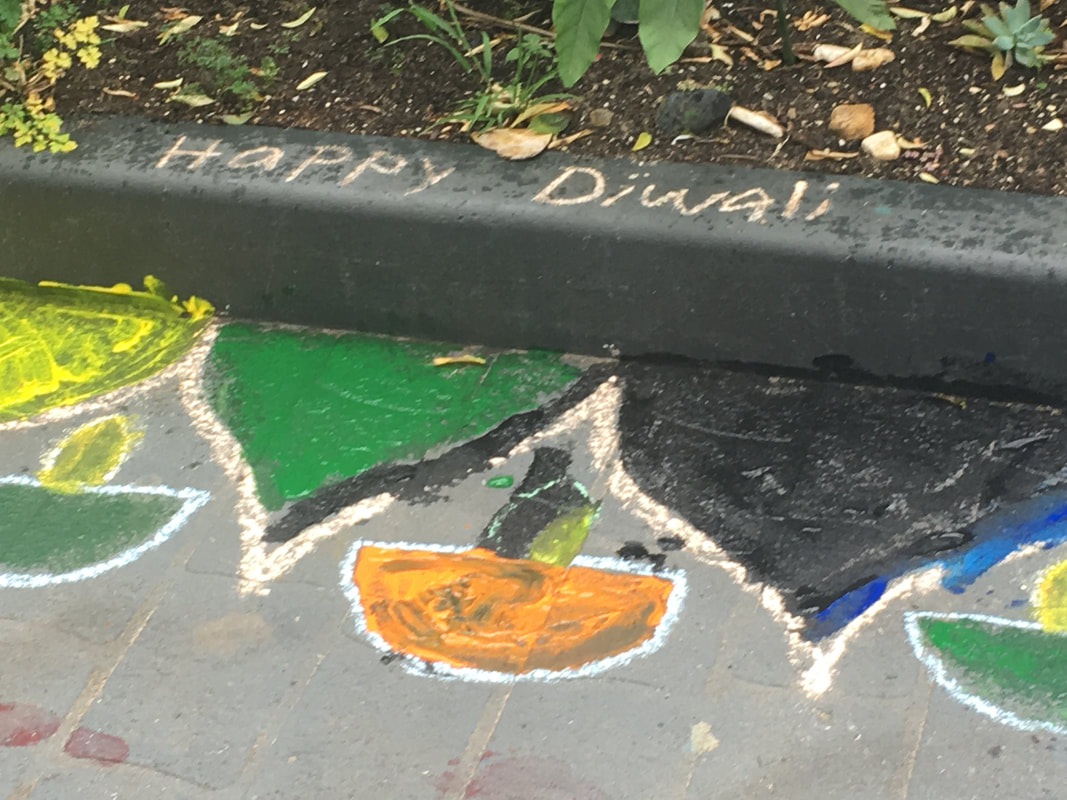
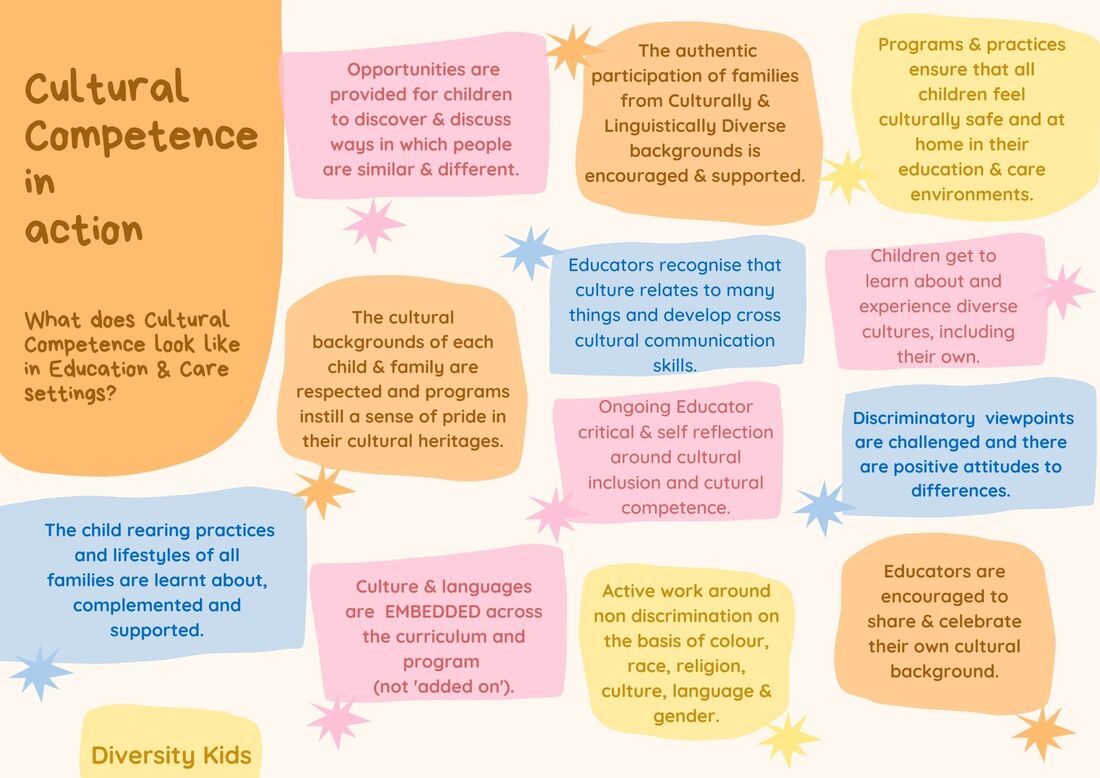
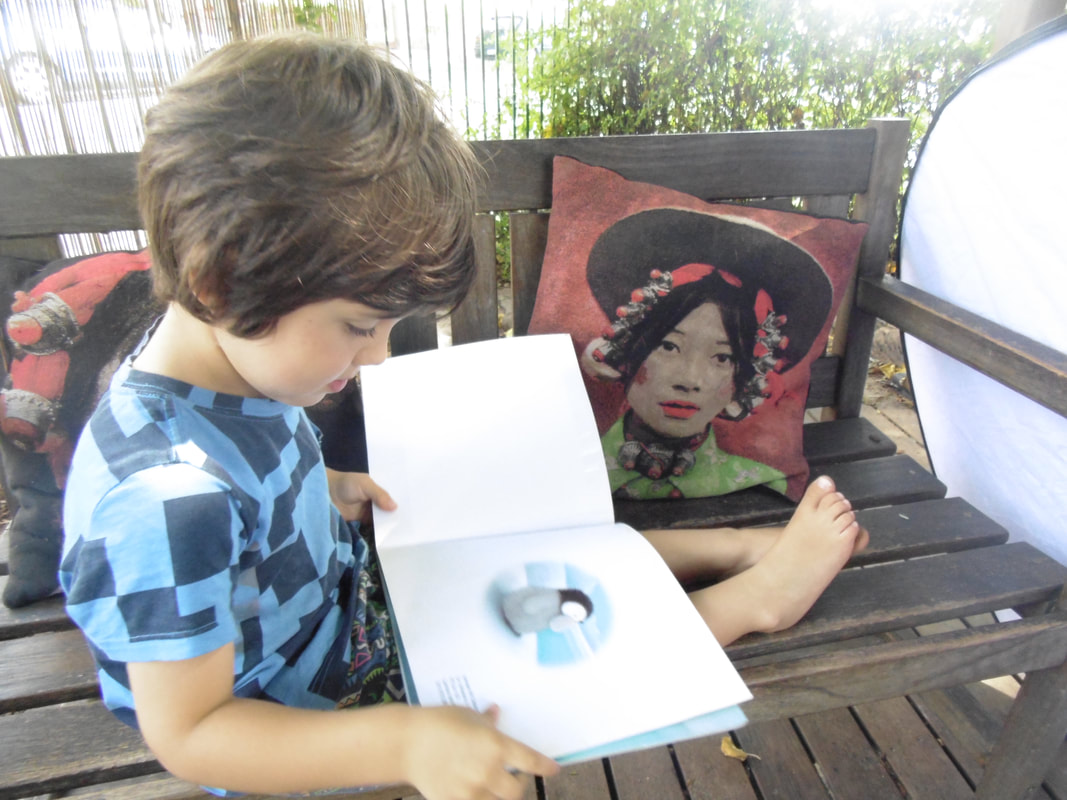
 RSS Feed
RSS Feed